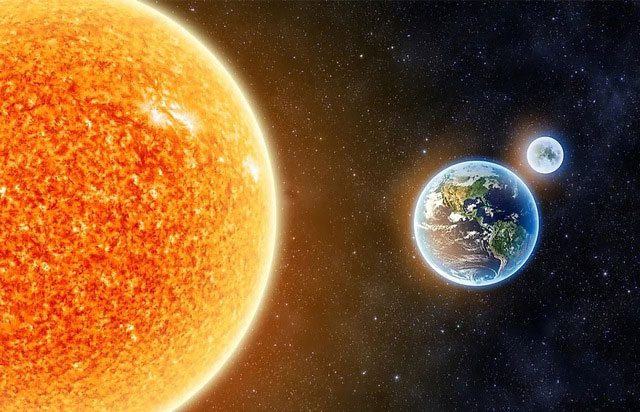Until now, the Sun has always been a star that humanity has not been able to reach due to its tremendous heat. Scientists believe that in the future, with advancements in science and technology, we may be able to approach the Sun. So, what will astronauts see when they land on this star?
How to Get Close to the Sun?
Many people liken the Sun to a giant fireball that warms humanity. Indeed, this is true, as at the coolest point of the Sun, the temperature is still 5,504 degrees Celsius. This is also the threshold temperature that can burn almost all materials known to man.

The coolest point of the Sun is 5,504 degrees Celsius. (Photo: NASA)
According to Ralph McNutt, an engineer at NASA, current astronaut suits are not designed to withstand deep space. Specifically, they can only endure temperatures up to 120 degrees Celsius. If the outside temperature exceeds 120 degrees Celsius, these suits would turn into steam rooms, causing the wearers to lose water and potentially die. Thus, humanity would instantly turn to dust if we crossed a distance of about 4.8 million kilometers from the Sun.
If humanity chooses to fly to the Sun using a space shuttle, we could get closer. The carbon-carbon reinforced heat shield (RCC) of the shuttle allows it to withstand external temperatures of nearly 2,600 degrees Celsius. If the entire spacecraft is coated with this thermal protection, astronauts could approach the Sun at a distance of 2 million kilometers. However, at this point, the protective layer of the shuttle would quickly deteriorate, and astronauts would have to turn back.
NASA has attempted to send the Parker Solar Probe into the Sun’s atmosphere to collect samples of particles from the solar corona. Launched in 2018, it conducted seven flybys of the Sun before diving into the corona during its eighth flyby on April 28, 2021. The Parker Probe was 13 million kilometers from the Sun’s center during its first passage through the corona.

With such high temperatures, humanity would instantly turn to dust if we crossed a distance of about 4.8 million kilometers from the Sun. (Photo: NASA)
The Parker Probe is protected by an 11.43 cm thick carbon-composite thermal shield, allowing it to withstand temperatures of up to 1,377 degrees Celsius, enabling it to approach the Sun at a distance of 6.16 million kilometers, nearly seven times greater than the record of 43 million kilometers set by the Helios 2 spacecraft in 1976. To overcome the immense gravitational pull of the Sun, the probe must travel through space at a speed of 692,000 kilometers per hour.
With what the Parker Probe has achieved, humanity can truly hope that in the future, we will land on the surface of the Sun. So, what will we see there?
What is Inside the Sun?
As mentioned earlier, when approaching the Sun, the first thing we encounter is the solar corona. The corona (or solar crown) is a halo of light emitted from the surrounding space of the Sun. This area has a low density of matter, scattering electromagnetic radiation from the Sun, creating weak light that can be observed when the Sun itself is obscured during a total solar eclipse. The corona reaches temperatures of up to 1 million degrees Celsius, while the photosphere of the Sun (what we usually see with the naked eye) is about 5,500 degrees Celsius.

The corona reaches temperatures of 1 million degrees Celsius, while the photosphere of the Sun is around 5,500 degrees Celsius. (Photo: NASA)
After passing through the corona, we reach the photosphere of the Sun. This is the visible surface of the Sun. Through decades of research, scientists estimate that the temperature of the photosphere is consistently around 6,000°C. The photosphere is about 100 km thick, and it is from this layer that all sunlight is radiated. Solar activities often occur in the photosphere due to the movement of plasma in the convective zone, creating strong magnetic fields. These magnetic fields are then pulled up from inside the Sun through convection and emerge at its visible surface as sunspots.
Beyond the photosphere, we have truly entered the interior of the Sun. The first stop is the convective zone. After traveling approximately 200,000 km (equivalent to 15 times the Earth’s diameter), we reach the second stop, the radiative zone. This zone of the Sun has a temperature of 2 million degrees Celsius. If we could see individual light particles, known as photons, we would see them bouncing between tiny particles called atoms, forming plasma. This zone has a temperature that can reach 15 million degrees Celsius.

The inside of the core of the Sun is believed to be pink. (Photo: NASA)
Finally, we reach the core of the Sun. But to enter this region, we must shrink ourselves to the size of an atom. Because only in this way can we see the atoms inside the core of the Sun, which are millions of times smaller than a grain of sand. These are hydrogen atoms, the lightest element in the universe. The incredible pressure and heat force these atoms close enough together that they fuse to form heavier atoms. This is known as nuclear fusion. Hydrogen atoms combine to create a completely new substance called helium. And the interior of the Sun’s core would have a beautiful pink hue.


















































